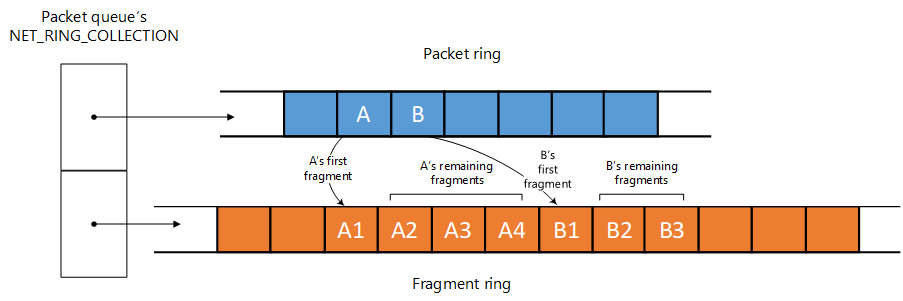Introduction to net rings
NET_RING overview
A NET_RING is a circular buffer of network data that is shared between NetAdapterCx and a client driver. Every packet queue in a client driver has two rings: a packet ring for core packet descriptors, and a fragment ring for each packet's fragment descriptors.
For more information about packet descriptors, see Packet descriptors and extensions.
Every core descriptor in the packet ring has indices into the fragment ring for locating that packet's fragment descriptors. Another data structure, the NET_RING_COLLECTION, groups the packet ring and fragment ring together for a given packet queue as shown in the following diagram.

Every packet queue has its own NET_RING_COLLECTION structure, and, consequently, its own packet ring, fragment ring, and descriptors in those rings. Therefore, the network data transfer operation of each packet queue is completely independent. To learn more about packet queues, see Transmit and receive queues.
NET_RING element ownership
Each element in a NET_RING is owned by either the client driver or NetAdapterCx. Ownership is controlled by three indices, which mark sections of the NET_RING. These indices are described in the following table. The act of moving these indices is described by post and drain semantics.
| NET_RING index name | Description | Required for transferring network data | Modified by |
|---|---|---|---|
| BeginIndex | The beginning of the range of elements in the NET_RING that the NIC client driver owns. BeginIndex is also the beginning of the drain subsection of the NET_RING. When BeginIndex is incremented, the driver drains the elements from the ring and transfers ownership of them to the OS. | Yes | NIC client driver |
| NextIndex | The beginning of the post subsection of the NET_RING. NextIndex divides the section of the ring that the client driver owns into the post and drain subsections. When NextIndex is incremented, the driver posts the buffers to hardware and transfers the buffers to the drain section of the ring. | No | NIC client driver |
| EndIndex | The end of the range of elements in the NET_RING that the NIC client driver owns. Client drivers own elements up to EndIndex - 1 inclusive. | Yes | NetAdapterCx |
Manipulating these indices during a packet queue's EvtPacketQueueAdvance callback is how client drivers transfer network data between the system and the network interface card (NIC) hardware.
Client drivers own every element from BeginIndex to EndIndex - 1 inclusive. For example, if BeginIndex is 2 and EndIndex is 5, the client driver owns three elements: the elements with index values 2, 3, and 4.
If BeginIndex is equal to EndIndex, the client driver does not own any elements.
NetAdapterCx posts elements to the ring buffer by incrementing EndIndex. A client driver drains the buffers and returns ownership of the elements by advancing BeginIndex.
NextIndex is optional for client drivers to use, and is provided for convenience in separating the post and drain subsections of the client driver's section of the ring.
Elements with index values between NextIndex and EndIndex - 1 inclusive are owned by the client but have not yet been posted to hardware. If NextIndex is equal to BeginIndex, the client driver does not have any completed buffers to transfer to the OS. If NextIndex is equal to EndIndex, the client driver does not have any buffers to post to hardware.
Because the net ring is circular, eventually the index values wrap around the end of the buffer and come back to the beginning. NetAdapterCx automatically handles wrapping the index values around the ring when the client driver calls the appropriate method.
For specific information about managing the elements in net rings, see Net ring element management.
Sending and receiving network data with net rings
See the following topics for more information and code samples about sending and receiving network data in net rings.